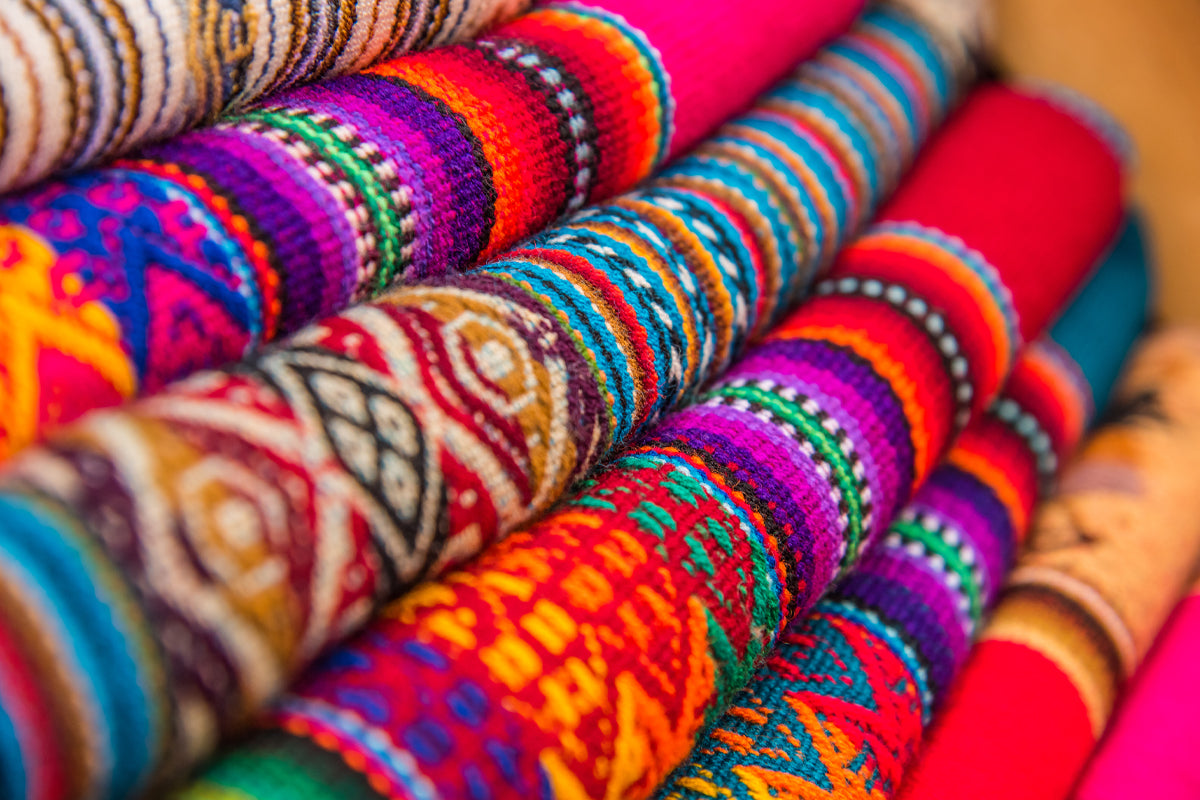Fabrics and Textiles: The Mastery of Inca Textile Art
The rich cultural heritage of the Incas is manifested in their impressive textile art, a fundamental element of their civilization. Inca fabrics and textiles are not only examples of technical skill but also of deep meanings that reflect the life, beliefs, and environment of this society. This blog explores the various aspects of the mastery of Inca textile art, from the raw materials used to the symbolic patterns, offering a comprehensive view of their historical and cultural relevance.
Raw Materials and Weaving Techniques
The Incas employ a variety of raw materials in their textiles, with alpaca and llama wool being the most prominent. These fibers are valued for their softness, durability, and thermal properties. The process of obtaining the wool begins with shearing, followed by careful washing and drying. The Inca weaving technique is characterized by the use of a backstrap loom, which allows artisans to create intricate patterns. This method not only provides flexibility in design but also reflects the symbiotic relationship between the Incas and their environment. Through these materials and techniques, textiles become works of art that transcend their utilitarian function.
Patterns and Symbolism
The patterns present in Inca textiles are rich in symbolism, each carrying a specific meaning that reflects aspects of daily life and Andean worldview. Motifs such as snakes, condors, and geometric elements are not merely decorative; they represent deities, the fertility of the land, and the cycle of life. Inca artisans use natural colors derived from plants and minerals to bring these designs to life, adding a layer of meaning to each garment. Through the observation of these patterns, one can glimpse the spirituality and connection of the Incas with nature and the universe, turning each textile into a testament to their cultural heritage.
The Role of Women in Textile Art
Women play a central role in the production of Inca textiles, being the primary weavers and guardians of this tradition. From a young age, girls are taught the art of weaving, learning not only techniques but also the meaning of patterns and the cultural value of their creations. This teaching process is a way to transmit ancestral knowledge and strengthen cultural identity. The fabrics crafted by women are not only used in daily clothing but are also gifted in important ceremonies, highlighting their relevance in the social and spiritual life of the community. Thus, textile art becomes a form of empowerment and feminine expression.
Textiles in Inca Ceremonial Practices
Textiles hold a prominent place in Inca ceremonial practices, playing an essential role in rituals and festivities. Garments made with specific designs are used in religious ceremonies, underscoring the importance of textile art in the spiritual life of the Incas. Priests and community leaders wear cloaks and tunics that symbolize their status and connection to the divine. Textiles are also offered to the gods, evidencing the belief in the necessity of thanking deities for the fertility of the land and the prosperity of the community. This connection between textiles and spirituality highlights their cultural significance beyond their utilitarian function.
The Legacy of Inca Textiles
The legacy of Inca textiles endures to this day, influencing both contemporary indigenous communities and global fashion. The quality and designs of Inca fabrics are admired worldwide, inspiring designers and artists to incorporate Andean elements into their creations. This revival of interest in traditional techniques also contributes to the preservation of cultural practices in Peru. Textile markets in the Andes become spaces where these traditions are celebrated, ensuring that Inca textile art remains alive in the collective consciousness. Contemporary appreciation for Inca textiles evidences their relevance in the cultural identity of the region.
Sustainability in Textile Production
Inca textiles are an early example of sustainability in production. Traditional techniques involve responsible use of natural resources, ensuring that raw materials are obtained in ways that do not harm the environment. The breeding of alpacas and llamas is conducted with respect for their welfare, and colors are extracted from plant sources, avoiding harmful chemical products. This connection between textile art and sustainability resonates today, where there is a growing interest in eco-friendly practices in the fashion industry. The study of Inca techniques offers valuable lessons on how to integrate sustainability into modern textile production.
Conservation and Appreciation of Inca Textiles
The conservation of Inca textiles is crucial for preserving this cultural heritage. Museums and research centers are dedicated to the collection and study of these pieces, ensuring their care and protection against the threats of time. Inca textiles are considered not only works of art but also testimonies of a civilization that influenced the history of South America. The appreciation of these objects extends beyond their aesthetic beauty, recognizing their cultural significance and their role in the identity of contemporary indigenous communities. Through exhibitions and educational programs, greater awareness is fostered regarding the importance of preserving this textile heritage.
Inca textile art represents an intersection between functionality and spirituality, highlighting the mastery of a civilization that deeply valued aesthetics and meaning in each of its fabrics. Through raw materials, symbolic patterns, and the crucial role of women, the cultural richness of the Incas is evidenced. Their legacy endures in contemporary times, inspiring sustainable practices and celebrating Andean cultural identity. The conservation and appreciation of these textiles ensure that this heritage continues to be a vital part of Peru's history and culture.
Sources Consulted
- Niles, Susan (1999). The Incas: A History of the Empire. New York: W. W. Norton & Company.
- De la Vega, John (2015). Textiles and Identity in the Inca Empire. London: University College London Press.
- Urton, Gary (2017). The History of the Andean People: An Anthropological Perspective. Boston: Cambridge University Press.
- D'Altroy, Teresa (2002). The Incas. Cambridge: Cambridge University Press.
- Coe, Michael (2015). Mexico: From the Olmecs to the Aztecs. New York: Thames & Hudson.
Article originally published on [12/27/2022], updated on [10/23/2024]


